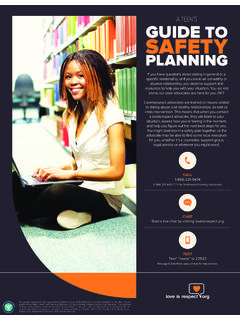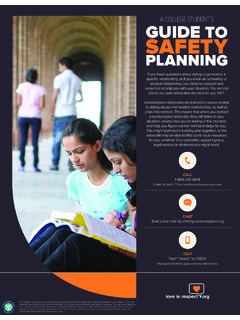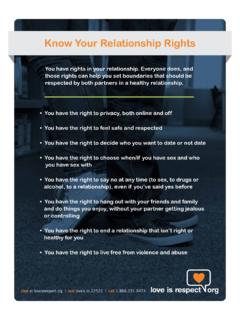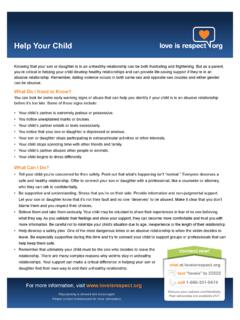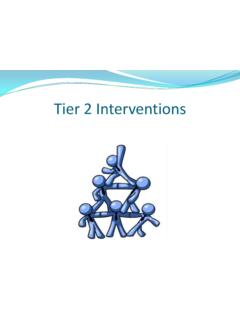Transcription of HEALTHY RELATIONSHIP MIDDLE SCHOOL EDUCATORS …
1 HEALTHY RELATIONSHIP EDUCATORS Toolkit1 HEALTHY RELATIONSHIP MIDDLE SCHOOLEDUCATORS TOOLKITH ealthy RELATIONSHIP EDUCATORS Toolkit2 About the Guide 3 Defining HEALTHY Relationships & Characteristics 4 Defining Unhealthy Relationships & Dating Abuse 5 Warning Signs of Abuse 6 How to Help Your Student 7 HEALTHY Relationships Curriculum Discussion Guides 8 Communicating Effectively 9 Resolving Conflict 11 Stepping In 13 Activities 15 TABLE OF CONTENTSH ealthy RELATIONSHIP EDUCATORS Toolkit3 ABOUT THIS GUIDEA bout loveisrespectloveisrespect s mission is to engage, educate and empower young people to end abusive relationships.
2 It is a project of the National Domestic Violence Hotline and Break the Cycle. Connect with us!There is NO EXCUSE for abuse, and no one deserves to be abused. For support, information and resources talk to a loveisrespect peer advocate, 24/7/365:Call 1-866-331-9474 Chat at loveis to 22522 Follow loveisrespect on social media for information and updates to share with your friends and /loveisrespectpageTwitter @loveisrespectInstagram @loveisrespectofficialEvery day millions of lives in the are devastated by violence. On average, 24 people a minute are victims of physical violence, rape or stalking by an intimate partner. That adds up to more than 12 million women and men a year.
3 The reality is that this doesn t only affect adults. There are millions of young people in this country, many of whom may be students of yours, whose lives are affected sometimes shaped by violence. The FactsOne in three adolescents in the is a victim of emotional, physical or sexual abuse from a dating partner, a figure that far exceeds other types of youth 33% of teens who were in a violent RELATIONSHIP ever told anyone about the abuse affects around million teens an educator, you are in a position to influence, motivate and lead children and youth. As a mentor and role model to your students, you play a critical role in shaping their attitudes and behaviors.
4 You have the ability to help them get an understanding of HEALTHY relationships and learn to recognize the signs of an unhealthy or abusive RELATIONSHIP . By leveraging classroom discussion, special projects and modeling the appropriate behaviors through your own words and actions, you can have a tremendous impact on how your students grow to understand and appreciate safe, HEALTHY and respectful that in mind, we created this toolkit. It serves as a compliment to the HEALTHY Relationships curriculum created by EverFi, Inc. However, the contents and ideas in this toolkit may be used separate and apart from that curriculum. It is our hope that you will feel free to use this guide because we believe that the way to prevent and end domestic violence and dating abuse is through RELATIONSHIP EDUCATORS Toolkit4 DEFINING HEALTHY RELATIONSHIPSC ommunication is a key part of building a HEALTHY RELATIONSHIP .
5 The first step is making sure both partners in a RELATIONSHIP want and expect the same things being on the same page is very important. The following tips can help your students create and maintain a HEALTHY RELATIONSHIP : Speak Up. In a HEALTHY RELATIONSHIP , if something is bothering them, it s best to talk about it instead of holding it in. Respect Each Other. Each partner s wishes and feelings have value. Let each other know they are making an effort to keep their ideas in mind. Mutual respect is essential in maintaining HEALTHY relationships. Compromise. Disagreements are a natural part of HEALTHY relationships, but it s important that they find a way to compromise if they disagree on something.
6 They should try to solve conflicts in a fair and rational way. Be Supportive. Offer reassurance and encouragement to each other in a RELATIONSHIP . Also, partners should let each other know when they need their support. HEALTHY relationships are about building each other up, not putting each other down. Respect Each Other s Privacy. Just because someone is in a RELATIONSHIP doesn t mean they have to share everything and constantly be HEALTHY BoundariesHealthy relationships require space. Creating HEALTHY boundaries is a good way to keep relationships HEALTHY and secure. By setting boundaries together, partners can have a deeper understanding of the type of RELATIONSHIP they each want.
7 Boundaries are not meant to make anyone feel trapped or like they are walking on eggshells. Creating boundaries is not a sign of secrecy or distrust it s an expression of what makes someone feel comfortable and what they would like or not like to happen within the RELATIONSHIP . HEALTHY boundaries shouldn t restrict someone s ability to: Go out with their friends without their partner. Participate in activities and hobbies they like. Not have to share passwords to their email, social media accounts or phone. Respect each other s individual likes and needs. HEALTHY RELATIONSHIP EDUCATORS Toolkit5 DEFINING UNHEALTHY RELATIONSHIPS & DATING ABUSER elationships that are not HEALTHY are based on power and control, not equality and respect.
8 In the early stages of an abusive RELATIONSHIP , your students may not think the unhealthy behaviors are a big deal. However, possessiveness, insults, jealous accusations, yelling, humiliation, pulling hair, pushing or other negative, abusive behaviors, are at their root exertions of power and control. Remember that abuse is always a choice and you deserve to be respected. There is no excuse for abuse of any abuse is a pattern of destructive behaviors used to exert power and control over a dating partner. While we define dating violence as a pattern, that doesn t mean the first instance of abuse is not dating violence. It just recognizes that dating violence usually involves a series of abusive behaviors over a course of violence can happen to anyone, regardless of age, race, gender, sexual orientation or background.
9 Drugs and alcohol can affect a person s judgment and behavior, but they do not excuse abuse or violence. Dating violence can be: Physical: hitting, slapping, choking, kicking Emotional/Verbal: putting you down; embarrassing you in public (online or off); threatening you in any way; telling you what to do or what to wear Sexual: pressuring or forcing you to do anything sexual, including sexting; restricting access to birth control Financial: taking your paychecks; preventing you from working Digital: sending threats via text, social media or email; stalking or humiliating you on social media; logging into your social media or email accounts without permission.
10 Forcing you to share passwords HEALTHY RELATIONSHIP EDUCATORS Toolkit6 WARNING SIGNS OF ABUSEW arning Signs of AbuseBecause relationships exist on a spectrum, it can be hard to tell when a behavior crosses the line from HEALTHY to unhealthy or even abusive. The following are warning signs of a RELATIONSHIP going in the wrong direction: Constantly putting someone down Extreme jealousy or insecurity Explosive temper Isolating someone from their family or friends, dictating who they can see or hang out with Mood swings (nice one minute and angry the next) Checking someone s cell phone, social media or email without permission Physically hurting someone in any way Possessiveness Telling someone what to do or what to wearNot sure if one of your students is in trouble?
